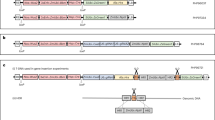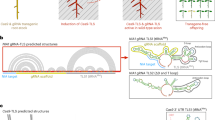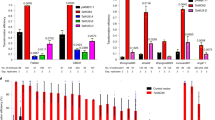Abstract
Genetic transformation of maize has been limited to a small number of genotypes that form embryogenie tissue in culture. We have investigated whether cells in the developing shoot meristem of immature zygotic embryos might provide an alternative, more universal target for production of transformed maize plants. Following DNA delivery mediated by microprojectile bombardment, immature embryos developed into chimeric plants with transgenic sectors containing an antibiotic resistance marker and the ß-glucuronidase (GUS) gene at a high frequency. Because the majority of transgenic sectors were restricted in size, the probability of a transformation event contributing to the germline without further manipulation was low. To enlarge the transgenic sectors and increase the likelihood of germline transmission, the apical meristems of germinated plants were excised and cultured on cytokinin-containing medium with a selective agent. Transformed sectors were visualized by their non-bleached phenotype or by staining with a GUS histochemical stain. Hormonally-induced shoot multiplication produced plants with sectors that had a greater chance of contributing to the germline. Transmission to progeny was demonstrated both by transgene expression and by Southern analysis. This method has been used successfully with genotypes that include a sweet corn hybrid and an elite field corn inbred.
This is a preview of subscription content, access via your institution
Access options
Subscribe to this journal
Receive 12 print issues and online access
$209.00 per year
only $17.42 per issue
Buy this article
- Purchase on Springer Link
- Instant access to full article PDF
Prices may be subject to local taxes which are calculated during checkout
Similar content being viewed by others
References
Vasil, I.K. 1994. Molecular improvement of cereals. Plant Molecular Biology 25: 925–937.
Armstrong, C.L. 1994. Regeneration of plants from somatic cell cultures; applications for in vitro genetic manipulation, p. 663–677. In: The Maize Handbook. Freeling, M. and Walbot, V. (Eds.). Springer-Verlag, New York.
Fromm, M.E., Morrish, F., Armstrong, C., Williams, R., Thomas, J. and Klein, T.M. 1990. Inheritance and expression of chimeric genes in the progeny of transgenic maize plants. Bio/Technology 8: 833–839.
Gordon-Kamm, W. J., Spencer, T.M., Mangano, M.L., Adams, T.R., Daines, R.J., Start, W.G., O'Brien, J.V., Chambers, S.A., Adams, W.R., Jr., Willetts, N.G., Rice, T.B., Mackey, C.J., Krueger, R.W., Kausch, A.P. and Lemaux, P.G. 1990. Transformation of maize cells and regeneration of fertile transgenic plants. The Plant Cell 2: 603–618.
D'Halluin, K., Bonne, E., Bossut, M., De Beuckeleer, M. and Leemans, J. 1992. Transgenic maize plants by tissue electroporation. The Plant Cell 4: 1495–1505.
Koziel, M.G., Beland, G.L., Bowman, C., Carozzi, N.B., Crenshaw, R., Crossland, L., Dawson, J., Desai, N., Hill, M., Kadwell, S., Launis, K., Lewis, K., Maddox, D., McPherson, K., Meghji, M.R., Merlin, E., Rhodes, R., Warren, G.W., Wright, M. and Evola, S.V. 1993. Field performance of elite transgenic maize plants expressing an insecticidal protein derived from Bacillus thuringiensis. Bio/Technology 11: 194–200.
Wan, Y., Widholm, J.M. and Lemaux, P.G. 1993. Maize transformation and regeneration of transgenic plants by microprojectile bombardment of Type I callus. 35th Annual Maize Genetic Conference. Pheasant Run Resort, St. Charles, Illinois.
Armstrong, C.L., Romero-Steverson, J. and Hodges, T.K. 1992. Improved tissue culture response of an elite maize inbred through backcross breeding, and identification of chromosomal regions important for regeneration by RFLP analysis. Theor. Appl. Genet. 84: 755–762.
Cowen, N.M., Johnson, C.D., Armstrong, K., Miller, M., Woosley, A., Pescitelli, S., Skokut, M., Belmar, S. and Petolino, J.F. 1992. Mapping genes conditioning in vitro androgenesis in maize using RFLP analysis. Theor Appl Genet 84: 720–724.
Wan, Y., Rocheford, T.R. and Widholm, J.M. 1992. RFLP analysis to identify putative chromosomal regions involved in the anther culture response and callus formation of maize. Theor. Appl. Genet 85: 360–365.
Duvick, D.N. 1992. Genetic contributions to advances in yield of U.S. maize. Maydica 37: 69–79.
Armstrong, C.L., Green, C.E. and Phillips, R.L. 1991. Development and availability of germplasm with high Type II culture formation response. Maize Genetics Cooperation Newsletter 65: 92–93.
Zhong, H., Srinivasan, C. and Sticklen, M.B. 1992. In-vitro morphogenesis of corn (Zea mays L.) I. Differentiation of multiple shoot clumps and somatic embryos from shoot tips. Planta 187: 483–489.
Bowen, B., Ludwig, S., Beach, L. and Wessler, S. 1989. R genes as visual markers for corn transformation, p. 81. In: Molecular Communication in Higher Plants; Proceedings of the Fifteenth EMBO Symposium.
Bowen, B. 1992. Anthocyanin genes as visual markers in transformed maize tissues, p. 163–176. In: GUS Protocols: Using the GUS Gene as a Reporter of Gene Expression. Gallagher, S. R. (Ed.). Academic Press, NY.
Bowen, B. 1993. Markers for plant gene transfer, p. 89–123. In: Transgenic Plants. Kung, S. and Wu, R. (Eds.). Academic Press, NY.
Tomes, D. 1990. Transformation in corn: non-sexual gene transfer, p. 1–13. In: Twenty-Sixth Annual Illinois Corn Breeders School Symposium at the University of Illinois at Urbana-Champaign.
Cao, J., Wang, Y., Klein, T.M., Sanford, J. and Wu, R. 1990. Transformation of rice and maize using the Holistic process, p. 21–33. In: Plant Gene Transfer. Lamb, C. J. and Beachy, R. N. (Eds.). Wiley-Liss, NY.
Gambley, R.L., Ford, R. and Smith, G.R. 1993. Microprojectile transformation of sugarcane meristems and regeneration of shoots expressing ß-Glucuronidase. Plant Cell Reports 12: 343–346.
Bilang, R., Zhang, S., Leduc, N., Iglesias, V.A., Gisel, A., Simmonds, J., Potrykus, I. and Sautter, C. 1993. Transient gene expression in vegetative shoot apical meristems of wheat after ballistic microtargeting. The Plant Journal 4: 735–744.
Iglesias, V.A., Gisel, A., Bilang, R., Leduc, N., Potrykus, I. and Sautter, C. 1994. Transient expression of visible marker genes in meristem cells of wheat embryos after ballistic micro-targeting. Planta 192: 84–91.
Lusardi, M.C., Neuhaus-Url, G., Potrykus, I. and Neuhaus, G. 1994. An approach towards genetically engineered cell fate mapping in maize using the Lc gene as a visible marker transactivation capacity of Lc vectors in differentiated maize cells and microinjection of Lc vectors into somatic embryos and shoot apical meristems. The Plant Journal 5: 571–582.
Steffensen, D.M. 1968. A reconstruction of cell development in the shoot apex of maize. Amer. J. Bot. 55: 354–369.
Johri, M.M. and Coe, E.H. 1982. Genetic approaches to meristem organization, p. 301–310. In: Maize for Biological Research. Sheridan, W. F. (Ed.). University of North Dakota Press, ND.
Poethig, R.S., Coe, E.H. Jr. and Johri, M.M. 1986. Cell lineage patterns in maize embryogenesis: a clonal analysis. Developmental Biology 117: 392–404.
McDaniel, C.N. and Poethig, R.S. 1988. Cell-lineage patterns in the shoot apical meristem of the germinating maize embryo. Planta 175: 1322.
Bossinger, G., Maddaloni, M., Motto, M. and Salamini, F. 1992. Formation and cell lineage patterns of the shoot apex of maize. The Plant Journal 2: 311–320.
Tilney-Bassett Richard, A.E. 1986. Plant Chimeras. Edward Arnold, London.
Chyi, Y. and Phillips, G.C. 1987. High efficiency Agrobacterium-mediated transformation of Lycopersicon based on conditions favorable for regeneration. Plant Cell Reports 6: 105–108.
McCabe, D.E., Swain, W.F., Martinell, B.J. and Christou, P. 1988. Stable transformation of soybean (Glycine max) by particle acceleration. Bio/Technology 6: 923–926.
McCabe, D.E. and Martinell, B.J. 1993. Transformation of elite cotton culti-vars via particle bombardment of meristems. Bio/Technology 11: 596–598.
Hajela, R.K., Hajela, N., Bolyard, M.G., Barnes, W.M. and Sticklen, M.B. 1993. A simple transformation system using adventitious shoot multiplication of Juneberry. HortScience 28: 330–332.
Dun-Yi, Y. and Krikorian, A.D. 1981. Multiplication of rice (Oryza saliva L.) from aseptically cultured nodes. Ann. Bot. 48: 255–259.
Dalton, S.J. and Dale, P.J. 1985. The application of in vitro tiller induction in Lolium multiflorum. Euphytica 34: 897–904.
Lee, T.S.G. 1987. Micropropagation of sugarcane (Saccharum spp.). Plant Cell Tissue and Organ Culture 10: 47–55.
Bhaskaran, S. and Smith, R.H. 1990. Regeneration in cereal tissue culture: A review. Crop Sci. 30: 1328–1336.
Finch, R.P., Baset, A., Slamet, I.H. and Cocking, E.C. 1992. In vitro shoot culture of wild Oryzae and other grass species. Plant Cell, Tissue and Organ Culture 30: 31–39.
Raman, K., Walden, D.B. and Greyson, R.I. 1980. Propagation of Zea mays L. by shoot tip culture: a feasibility study. Ann. Bot. 45: 183–189.
Walden, D.B., Greyson, R.I., Bommineni, V.R., Pareddy, D.R., Sanchez, J.P., Banasikowska, E. and Kudirka, D.T. 1989. Maize meristem culture and recovery of mature plants. Maydica 34: 263–275.
Santos, M.A., Torne, J.M. and Blanco, J.L. 1984. Methods of obtaining maize totipotent tissues. I. Seedling segments culture. Plant Science Letters 33: 309–315.
Lowe, K., Taylor, T.B., Ryan, P. and Paterson, K.E. 1985. Plant regeneration via organogenesis and embryogenesis in the maize inbred line B73. Plant Science 41: 125–132.
Jones, J.D.G., Svab, Z., Harper, E.C., Hurwitz, C.D. and Maliga, P. 1987. A dominant nuclear streptomycin resistance marker for plant cell transformation. Mol. Gen. Genet. 210: 86–91.
Svab, Z., Harper, E.C., Jones, J.D.G. and Maliga, P. 1990. Aminoglycoside-3′-adenyltransferase confers resistance to spectinomycin and streptomycin in Nicotiana tabacum. Plant Molecular Biology 14: 197–205.
Chalfie, M., Tu, Y., Euskirchen, G., Ward, W.W. and Prasher, D.C. 1994. Green fluorescent protein as a marker for gene expression. Science 263: 802–805.
Ludwig, S., Bowen, B., Beach, L. and Wessler, S. 1990. A regulatory gene as a novel visible marker for maize transformation. Science 247: 449–450.
Goff, S.A., Klein, T.M., Roth, B.A., Fromm, M.E., Cone, K.C., Pablo Radicella, J. and Chandler, V.L. 1990. Transactivation of anthocyanin bio-synthetic genes following transfer of B regulatory genes into maize tissues. EMBO J. 9: 2517–2522.
Register, J.C. III, Peterson, D.J., Bell, P.J., Bullock, W.P., Evans, I.J., Frame, B., Greeland, A.J., Higgs, N.S., Jepson, I., Jiao, S., Lewnau, C.J., Sillic, J.M. and Wilson, H.M. 1994. Structure and function of selectable and non-selectable transgenes in maize after introduction by particle bombardment. Plant Mol Biol 25: 951–961.
Paszkowski, J. (Ed.). 1994. Homologous Recombination and Gene Silencing in Plants. Kluwer Academic Publishers, Boston, MA.
McElroy, D. and Brettell, R.I.S. 1994. Foreign gene expression in transgenic cereals. Trends in Biotechnology 12: 62–68.
Simpson, J., Van Montagu, M. and Herrera-Estrella, L. 1986. Photosynthesis-associated gene families: Differences in response to tissue-specific and environmental factors. Science 233: 34–48.
Ritala, A., Aspegren, K., Kurten, U., Salmenkallio-Marttila, M., Monnonen, L., Hannus, R., Kauppinen, V., Teeri, T.H. and Enari, T. 1994. Fertile transgenic barley by particle bombardment of immature embryos. Plant Mol Biol 24: 317–325.
Songstad, D.D., Somers, D.A. and Griesbach, R.J. 1995. Advances in alternative DNA delivery techniques. Plant Cell Tissue and Organ Culture 40: 1 15.
Abbe, E.C. and Stein, O.L. 1954. The growth of the shoot apex in maize: embryogeny. American Journal of Botany 41: 285–293.
Murashige, T. and Skoog, F. 1962. A revised medium for rapid growth and bioassays with tobacco tissue cultures. Physiol. Plant. 15: 473–497.
Jefferson, R.A., Burgess, S.M. and Hirsh, D. 1986. ß-Glucuronidase from Escherichia coli as a gene fusion marker. Proc. Natl. Acad. Sci. USA 83: 8447–8451.
Beck, E., Ludwig, G., Auerswald, E.A., Reiss, B. and Schaller, H. 1982. Nucleotide sequence and exact localization of the neomycin phosphotransferase gene from transposon Tn5. Gene 19: 327–336.
Gardner, R.C., Howarth, A.J., Hahn, P., Brow-Luedi, M., Shepherd, R.J. and Messing, J.C. 1981. The complete nucleotide sequence of an infectious clone of cauliflower mosaic virus by M13mp7 shotgun sequencing. Nucl. Acids Res. 9: 2871–2888.
Gallie, D.R., Sleat, D.E., Watts, J.W., Turner, P.C. and Wilson, T.M.A. 1987. The 5′-leader sequence of tobacco mosaic virus RNA enhances the expression of foreign gene transcripts in vitro and in vivo. Nucl. Acids Res. 15: 2871–2888.
Dennis, E., Gerlach, W., Pryor, A., Bennetzen, J., Inglis, A., Llewellyn, D., Sachs, M., Feri, R. and Peacock, W. 1984. Molecular characterization of the maize Adhl gene. Nucl. Acids Res. 12: 3983–3990.
An, G., Mitra, A., Choi, H.K., Costa, M.A., An, K., Thornburg, R.W. and Ryan, C.A. 1989. Functional analysis of the 3′ control region of the potato wound-inducible proteinase inhibitor II gene. Plant Cell 1: 115–122.
Christensen, A.H., Sharrock, R.A. and Quail, P.H. 1992. Maize polyubiquitin genes: structure, thermal perturbation of expression and transcript splicing, and promoter activity following transfer to protoplasts by electroporation. Plant Mol. Biol. 18: 675–689.
Sullivan, T.D., Christensen, A.H. and Quail, P.H. 1989. Isolation and characterisation of a maize chlorophyll a/b binding protein gene that produces high levels of mRNA in the dark. Mol. Gen. Genetic. 215: 431–440.
Jones, J.D.G., Shlumukov, K., Carland, F., English, J., Scofield, S.R., Bishop, G.J. and Harrison, K. 1992. Effective vectors for transformation, expression of heterologous genes, and assaying transposon excision in transgenic plants. Transgenic Research 1: 285–297.
Jefferson, R. 1987. Assaying chimeric genes in plants: the GUS gene fusion system. Plant Mol. Biol. Rep. 5: 387–405.
Rogers, S.O. and Bendich, A.J. 1985. Extraction of DNA from milligram amounts of fresh, herbarium and mummified plant tissues. Plant Mol. Biol. 5: 69–73.
Rao, G. and Flynn, P. 1990. A quantitative assay for ß-D-glucuronidase (GUS) using microtiter plates. BioTechniques 8: 38–40.
Author information
Authors and Affiliations
Corresponding author
Rights and permissions
About this article
Cite this article
Lowe, K., Bowen, B., Hoerster, G. et al. Germline Transformation of Maize Following Manipulation of Chimeric Shoot Meristems. Nat Biotechnol 13, 677–682 (1995). https://doi.org/10.1038/nbt0795-677
Received:
Accepted:
Issue Date:
DOI: https://doi.org/10.1038/nbt0795-677
This article is cited by
-
Efficient plant regeneration from shoot apex explants of maize (Zea mays) and analysis of genetic fidelity of regenerated plants by ISSR markers
Plant Cell, Tissue and Organ Culture (PCTOC) (2014)



